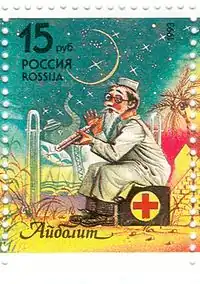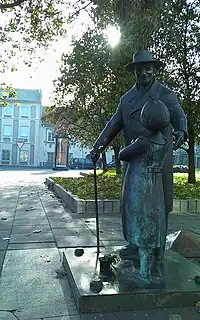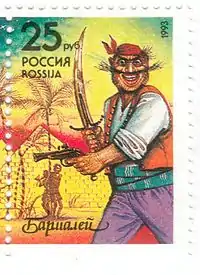Doctor Aybolit
Doctor Aybolit (Russian: Доктор Айболит, Doktor Aibolit) is a fictional character from the children's poems Aybolit (1929) and Barmaley (1925) by Korney Chukovsky, as well as from the children's fantastic novella Doctor Aybolit (1925) by the same author. The name may be translated as "Ai" ("Ouch"), "Bolit" ([it] hurts!)".

Origins
The origins of Aybolit is Hugh Lofting's 1920 character Doctor Dolittle, Doctor Aybolit being its loose adaptation. The first 1924 edition of Doctor Aybolit was titled "Лофтинг Гью. Доктор Айболит. Для маленьких детей пересказал К. Чуковский" ("Lofting Gyu (sic!), Doctor Aybolit. Retold for little children by K. Chukovsky").[1] In the adaptation the plot was drastically reworked to simplify the perception by little children and this, in addition to ignorant accusations in plagiarism, was a subject of "holy wars" in Russian literary circles in 1990s when faithful translations of Doctor Dolittle stories appeared in Russian.[2]

A living prototype of the character was Chukovsky's acquaintance, the Vilnian Jewish physician Zemach Shabad (1864–1935), whom he met in 1912. Chykovsky desribed him in his memoirs as "the nicest man I knew. <...> Not only children visited him themselves, but also they were bringing sick animals."[3] A monument to Zemach Chabad[lower-alpha 1] was dedicated in Vilnius on 16 May 2007. In Lithuanian language, Doctor Aybolit is translated as Daktaras Aiskauda. However the very first Doctor Aybolit book contains a dedication "Посвящаю милому доктору Конухесу[lower-alpha 2], целителю моих Чуковлят" ("Dedicated to dear Doctor Konukhes, the healer of my Chukovlings")[6]
Influence
The character became a recognizable feature of Russian culture. The poems found their following in the films Doktor Aybolit (black and white, 1938), Aybolit 66 (Mosfilm, 1967, English title: Oh How It Hurts 66), and Doctor Aybolit (animated film, Kievnauchfilm, 1985). The doctor's appearance and name appear in brand names, logos, and slogans of various medical establishments, candies, etc.

Aybolit's antagonist, the evil pirate Barmaley, became an archetypal villain in Russian culture. Barmaley debuted in Chukovsky's book Barmaley in 1925, 13 years before the first film appearance of Aybolit.[6] There is the Barmaley Fountain in Volgograd.
The poems Aybolit and Barmaley generated a number of Russian catchphrases such as "Nu spasibo tebe, Aybolit!" (Thanks to you, Aybolit), "Ne hodite, deti, v Afriku gulyat" (Children, don't go to Africa for a stroll). They were also the inspiration for the Barmaley Fountain in Stalingrad.
In 1967 Richard N. Coe published a loose English adaptation in verse entitled Doctor Concocter.[7] It starts: "Doctor Concocter sits under a tree, He's ever so clever, he has a degree!"
Notes
References
- Лофтинг, Гью (Хью) Джон. Доктор Айболит. Для маленьких детей. Пересказал К. Чуковский. Рисунки Е. Белухи.
- Вдовенко И. В., Стратегии культурного перевода
- Цемах Шабад, еврейский доктор Айболит
- Vilniuje gyvenęs daktaras Aiskauda
- ПИСЬМА БЛОКА К К.И.ЧУКОВСКОМУ И ОТРЫВКИ ИЗ ДНЕВНИКА К.И.ЧУКОВСКОГО
- Чуковский К. Бармалей. Рисунки М. Добужинского. Ленинград, Радуга, 1925
- A review of Doctor Concocter, The Spectator, 1967, v. 219, p. 540
Bibliography
- Chukovsky, Kornei (1965), Doktor Aibolit, Harrap, p. 79, ISBN 978-0-245-58209-7
- Chukovskiĭ, Korneĭ (1967), Richard N. Coe (ed.), Doctor Concocter, translated by Richard N. Coe, Oxford University Press, p. 24, ISBN 978-0-19-279633-2
- Chukovsky, Kornei (1980), Doctor Powderpill, translated by D. Rottenberg, Central Books Ltd., ISBN 978-0-7147-1468-4
- Chukovskii, Kornei (1980), Doktor Aibolit (in Russian), Znanie Bookstore, ISBN 978-5-88105-113-6
- Chukovsky, Kornei (2004), Doctor Ouch, translated and illustrated by Jan Seabaugh, Smith Publishing, p. 43, ISBN 978-0-9740551-0-7
- Chukovskii, Kornei (2004), Ajbolit (in Russian), Samovar, ISBN 978-5-85066-263-9
- Čukovskij, Kornej (1999), Stichi i skazki: Ot dvuch do pjati (in Russian), Planeta detstva, p. 701, ISBN 978-5-236-00167-0. Extracts of Aybolit and Barmaley.